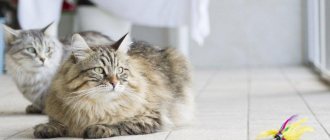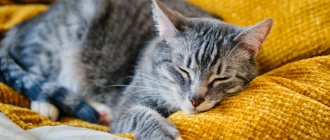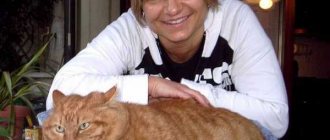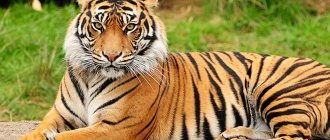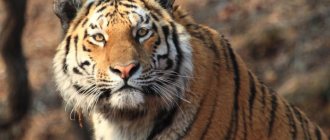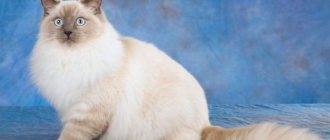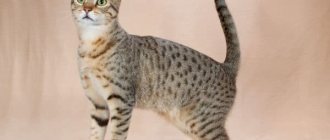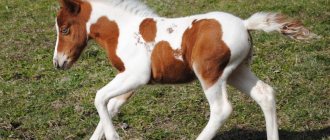Juan Pedro Franco (595)
The man lives in Mexico. In 2016, he was listed in the Guinness Book of Records as the heaviest person to weigh. Juan's recorded weight was just under 595 kg. The man started gaining weight after he had an accident at the age of 17, from which he was never able to fully recover. Franco suffers from many weight-related illnesses, including hypothyroidism, diabetes and hypertension. Lately, he has been trying to lose weight, with professionals helping him for free. The man has already lost 132 kg, his weight is now 453 kg. To do this, he underwent gastric bypass surgery, he also adheres to a strict diet and performs a special set of exercises.
Himmi
The title of the fattest cat in history goes to Himmy the cat. The animal belonged to Queensland Australian Thomas Wise. In 1986, the cat's weight was 21.3 kg. This weight is considered normal for a six-year-old child.
It is noteworthy that Himmi is the only cat in history whose record weight has been officially recorded:
- The indicators of the Australian cat were included in the old edition of the Guinness Book of Records.
- The animal was so huge and heavy that it needed a small wheeled wheelchair to move.
Until 1998, no one decided to apply for the record for the fattest cats. Afterwards, the editors of the Guinness Book decided not to record such records anymore. This is due to the fact that in pursuit of greater weight of the animal, the owners deliberately feed the pet.
Obesity is very dangerous for cats and causes many health problems. At the same time, the Guinness Book of Records continues to record records for size (including weight) among human-bred breeds, but not individual animals.
Chart of animal weight gain from birth to 2 years
The period of puberty is important. At this time, growth slows down. If cats come into heat 1-2 times a month, then growth may stop altogether
If you have sterilized a cat, then at first its body weight will increase slowly, but later there is a risk of obesity due to the fact that its immunity increases
If cats go into heat 1-2 times a month, then growth may stop altogether. If you have sterilized a cat, then at first its body weight will increase slowly, but later there is a threat of obesity due to the fact that its immunity increases.
A kitten's weight is a very important aspect of its development. The baby's weight needs to be monitored for several reasons. For example, by the age of one month, a kitten can weigh up to 500 grams. If his weight differs from this indicator in the direction of decrease, this may be caused by the following reasons:
- diseases, congenital or acquired;
- numerous litters;
- the mother’s lack of a complete diet that can provide nutrition for both the cat herself and her babies.
An underweight kitten may indicate that the baby is malnourished. He becomes lethargic, sleeps a lot, and apart from the general mass of kittens. In this case, you need to increase the amount of food for the nursing cat and monitor how long the weak baby stays at her breast.
Sometimes he still managed to get comfortable, but he quickly got tired and soon fell asleep without having eaten enough. Since I closely followed the adaptation of foundlings, I immediately noticed this (literally within 24 hours). The baby had to be fed separately. I gave him a special mixture, but also tried to get him to latch on to the cat’s breast more often (the more lively brothers had to be pushed aside for a while). As a result, this baby still lagged behind the others in weight, but caught up with them in height by about a year.
If a kitten is diagnosed with any disease, then to correctly calculate the medicinal suspension you will also need to know the exact weight of the animal. Therefore, a conscientious owner always monitors this indicator.
Every caring owner should keep a kitten's weight diary. This must be done regardless of whether the kitten grows up alone or with its mother cat and brothers. It is necessary to record all weight indicators in the diary, which can later help track whether the baby is developing normally.
The weight diary can be kept in any form, as convenient for the owner. This is an ordinary notebook for me. In it I write down the date of birth of the kittens, the names I gave them, as well as everything related to caring for them. This is not only their weight, but also the dates of treatment for fleas and worms, as well as the dosage of drugs (which, by the way, depends on weight).
There are several internal and external factors influencing the growth processes of a Scottish Fold cat kitten. Internal factors are presented:
- characteristics of the breed;
- gender;
- genotype of parents;
- individual genetic characteristics;
- hormonal characteristics.
External factors affecting the growth of an animal include keeping kittens during the neonatal and suckling periods, as well as the number of individuals in the litter, quality of sleep and dietary features of a nursing cat. Animals must be provided with a completely calm, stress-free environment, good and nutritious food, as well as high-quality hygienic care.
You can feed your Scottish Fold cat both natural products and ready-made dry or wet food. The second option, according to many breeders and veterinarians, is more preferable for normal growth and development, therefore it is recommended to purchase the following ready-made diets for feeding your pet:
- AATU;
- Asana;
- Applaws;
- Canagan;
- Сarnilove;
- Farmina N{amp}amp;D;
- Gather;
- Gina Elite;
- Go Natural;
- Grandorf;
- Nature;
- Now Fresh;
- Nutram;
- Orijen;
- Pronature Nolistis;
- Savara;
- Wellness CORE.
Weight standards for cats
Overweight is common in cats, just as it is in people. Multiple causes of this disease can lead to various diseases and pathologies, so owners of furry pets need to monitor their nutrition and health.
Obesity in a cat
What does a cat’s body weight depend on:
- Breed. It is worth noting that each member of the cat family has its own weight norm. Large breeds such as the Maine Coon weigh much more than their miniature counterparts (Persians, Sphynxes, etc.).
- Floor. Most often, a boy, for example a British breed, has a larger mass than a girl of the same breed. Males are generally larger than cats. The difference can be about 2 kg.
- Castration and sterilization. After these operations, the animal’s hormonal background changes, and therefore weight begins to increase.
- Diseases. Obesity can be a consequence of any disease or dysfunction of internal organs.
- Age. Young cats are smaller than older cats because they are more active and healthy.
- Constitution. The physique of cats is also individual: some are more muscular, while others are thin and graceful.
- Nutrition. Pets should be fed a balanced and high-quality diet.
- Lifestyle. Sedentary animals always weigh more than active ones.
Important! The most common breeds that are prone to gaining excess weight are Sphynxes, Britons, Persians, Exotics and Burmese. Owners of such breeds must be careful to prevent them from becoming obese.
How can you determine if your pet’s weight is normal? A fat cat has a noticeably large belly (apron), no waist, and a large muzzle. The ribs of such animals cannot be felt under the fat layer. A cat with a normal weight is active, he has a proportional body with a waist, the bones are palpable, but do not stick out.
Comparison of a healthy cat and an obese cat
The average weight for newborn kittens is 70-140 g. Gradually, they begin to add 15 g per day, and then 100 g by 2 months. Plump kittens are quite rare, as they are very active and their metabolism is still fast.
In a year, a cat will gain weight, which will remain there for many years to come if you monitor its health. To understand the norm of weight, we can take several fairly common breeds as an example. By the first year of life, a large representative of the Maine Coon reaches from 5.3 kg to 8.8 kg, and a representative - from 4.5 to 8.3 kg. Small British cats weigh about 2.5 - 4.6 kg, and male cats - 4.5 - 7 kg. The average-built Siberian breed weighs from 4.5 to 7 kg, regardless of gender.
Note! It is not worth making final conclusions about the weight of an animal based on the established average if it looks healthy and well-built. A cat that is too thin and has protruding bones cannot be healthy either. Diseases can also develop from malnutrition, as well as from overeating.
Meow, 18 kg
Meow the US cat gained international attention when he appeared on television on Anderson Live. He was given to a shelter by an elderly owner who could not care for the animal due to health reasons.
At the shelter, Meow was prescribed a weight loss program, including a strict diet. It was planned to publish the results of the cat’s weight loss on a Facebook page so that it would become popular and eventually find owners. After just a few weeks, Meow lost 0.9 kg, but the plan was to lose 4.5 kg. But the fat boy began having breathing problems and died of pulmonary failure on May 5, 2012, at the age of two. He was the fattest cat in the world at the time of his death.
The reason Meow got so fat wasn't because of overeating. The animal suffered from a severe urinary tract infection, which caused obesity.
How to prevent your cat from becoming obese
Obesity is defined as more than 15-20% excess weight, which is less than 1 kg of excess body weight for the average cat. Strict control over the amount of food is the only way to prevent obesity in your pet. This rule is important for castrated animals, because sex hormones no longer reduce appetite. Do not feed according to the principle: let him eat as much as he can . The animal does not understand that it has eaten more than it needs.
Excess fatty tissue in the body leads to disruption of the functioning of all internal organs of the animal. This interferes with freedom of movement, forcing the pet to lie down more. Obesity is dangerous due to overload of the heart and blood vessels, which ultimately shortens the cat's life.
Diseases of cats caused by excess weight:
- replacement of healthy liver cells with fat cells (lipidosis);
- joint inflammation (arthritis);
- renal failure;
- pulmonary edema;
- inflammation of the pancreas (pancreatitis);
- diabetes.
My cat is 1 year and 9 months old, outbred, neutered. Since childhood (from six months), the cat has been prone to obesity. After castration at 7 months, I didn’t gain weight for about 2 months, then I began to gain weight little by little. After this hot summer, my cat began to be confused with a pregnant cat. The cat is quite lazy, playing with him additionally is also not particularly effective; he will lie and watch the toy, but not run after it. He runs circles around the apartment with the cat 3-4 times a day, but, in my opinion, that’s not enough. They took urine and biochemistry tests - everything was normal. According to the ultrasound, there is just solid fat inside, fatty liver is starting, but it is not so critical yet, there is a chance to stop it.
DeepEyes
https://forum.bolen-kot.net.ru/index.php?showtopic=12974&st=15&start=15
Fat cats cannot groom themselves or use the toilet properly. If surgery is necessary, the use of anesthesia can be fatal.
The habit of eating a lot not only causes obesity, but also makes it difficult to reduce your pet’s weight to normal. Desperate, the owner surrenders to the mercy of the pet. A friend of mine had a mongrel cat who loved to sleep and eat. When the owner finally brought her lazy pet to the veterinarian for examination, he began to talk about cruelty to animals. And not in vain - the plump fat woman weighed more than 9 kg, but there were no serious health problems yet. The doctor prescribed a diet for weight loss. The hungry cat endured the first day, thinking that they forgot to buy her food. When she realized that the hostess was to blame, a riot began. Heaps and puddles appeared on the floor and in the corners of the apartment every day. It seemed that the cat had forgotten about the existence of the tray. Wanting to return to her previous nutrition, she began to disturb her owner’s sleep by climbing onto her bed at night. Then the teeth came into play: after eating a small portion of food, the cat bit the culprit of her troubles on the legs, demanding more. I had to buy a spacious cage and lock the ugly creature at night. But even then she came up with a way to annoy her: she began to meow loudly. Her hungry stomach gave neither her nor those around her rest. The neighbors were patient, but a few days later they called the police. I had to give explanations. After two weeks of “war” with the cat, the owner gave up and began feeding her as before. It was not possible to correct the previously committed mistake in keeping the animal.
Excess weight is bad for any pet, not just cats. With severe obesity, the internal organs are tense, and the muscles cannot support the weight. Because of this, it hurts the cat to get up and walk, and his back sags under the weight of his belly. Fat people are 4 times more likely to have diabetes. In the worst cases, animals die from cardiac and respiratory arrest.
I have a cat with obesity after sterilization, she is 10 years old. Mom was touched that she was fat, so nice, big - 7 kg. Already from blood biochemistry and urine analysis it was clear that the kidneys and liver were suffering. Now the cat is losing weight on hills metabolic. It’s already the 4th month and I’ve lost 800 grams in total.
Guest
https://www.woman.ru/home/animal/thread/4537595/
Maine Coon
These are the largest cats that came to us from the North American continent. In appearance, the cat resembles a lynx, but the breed is considered natural - that is, it was formed without artificial crossing. The characteristics of the breed are:
- Impressive body size.
- Tassels on the ears.
- Fluffy long tail.
- The head with a flat skull is of medium size.
- The nose is wide, with a dense line crossing the muzzle.
- Eyes – amber, light cats can have blue eyes or multi-colored ones (this phenomenon is called heterochromia).
- Interesting harmonious coloring.
- The coat is dense, silky with a dense undercoat, thanks to which the animal is not afraid of frost.
- Large developed limbs.
- Between the toes there are layers of wool, due to which the cat can walk on the snow crust without falling through.
The average weight of a male is up to 12 kg, and females are much lighter, only 5–6 kg. Some cats reach a weight of 15 kg.
The nature of cats is peaceful, they will happily play with their owner. Maine Coons are very smart, rarely feel anxious and are not prone to stress. Having decided to get yourself this giant cat, you should think about whether you will be ready to comb his luxurious fur at least twice a week for 30–40 minutes?
Chausie
These giant cats are direct descendants of Egyptian jungle cats; they were the result of crossing the latter with Abinsk cats. The cats are friendly, very affectionate, and love to play with their owner.
Average weight is from 5 to 15 kg, life expectancy is 10–20 years. In appearance, cats have many similarities with pumas:
- Slim muscular body.
- Small head with elongated cheekbones.
- Developed chin.
- Erect ears with tassels.
- Almond-shaped eyes.
- Powerful paws.
- The tail is long (according to the standard - at least ¾ of the body length).
- The coat is short, thick, dense.
Three colors:
- universal – black with silver tips;
- black;
- ticked brown tabby.
Content difficulties:
First of all, a kitten is quite expensive - from normal breeders it costs about 10 thousand dollars. The cat needs to be walked at least a couple of times a week. They cannot live in cramped apartments; they require a lot of space for active entertainment. Weak digestive system
It is important to ensure that no grains or vegetables accidentally get into your pet’s bowl. In general, the Chausie is a sweet and energetic breed of big cats with a friendly disposition, completely different from their wild counterparts
Overall, the Chausie is a sweet and energetic breed of big cat with a friendly disposition, completely unlike its wild counterparts.
Holding a white cat in your arms in a dream
In this case, dream books warn about a person who is already present in the sleeper’s life or will appear soon. This person is a skilled manipulator who can harm the reputation of the dreamer.
The dream warns that the manipulator must be recognized and exposed at all costs, otherwise you will only have yourself to blame.
A vision in which a white cat scratched a person is a message that in reality the dreamer will have to resist various negative circumstances for a long time.
If a person is attacked by several cats that bite and scratch him, then real circumstances will develop in such a way that he will find himself in a situation where he will need to prove his truth, justify his good name.
If a cat scratched an acquaintance, relative or friend of the sleeping person, then the dream promises a slight illness to the victim or speaks of the dreamer’s resentment towards him.
Fat cats from the Internet
The appearance of furry fatties on the Internet never goes unnoticed. People are ready to look at them every day, so their photos and videos are always in the top. Some get thousands and sometimes millions of views in a matter of days and become real celebrities. Often, when looking at such photos, you immediately want to go on a diet yourself. Sometimes fat cats try to get lost among the interior or blend in with the environment.
On the Internet you can find photographs of fat bellies getting stuck in various holes - this is the time to think about an emergency diet!
But still, most of them, at any weight, feel like the most beautiful and graceful creatures who have come into our lives for us to constantly admire them, regardless of whether they are fat or not.
In addition to photographs, owners of fat cats constantly strive to capture their pets on video, so we can enjoy watching fluffy fat cats having fun, funny asking for food or playing around like little children.
- Combating Pet Obesity
- Obesity in cats and kittens
- Standards for feeding cats and kittens with dry and wet food
Top fattest cats
Fat dogs: the fattest pets in the world
Below are the fattest cats known throughout the world. Unfortunately, the excessive love of their owners turned them into not only stars and cute fat cats, and this did not always end positively.
Fat American cat Meow
This plump cat lived in the USA in the state of New Mexico. His passion for food led him to reach 18 kg. The 87-year-old owner could not cope with the cat and gave him to a shelter for further care. Unfortunately, the cat’s body could not stand it, and at the age of 2, Meow died without completing the weight loss course.
Fat guy named Garfield
A fat red-haired man from New York gained 18 kg because the owner overfed the pet. Animal protection authorities took the cat in because they believed that the woman was doing this on purpose. They put him on a diet and found new owners for him.
Garfield the Cat
Black and white cat Tulle
A fat cat from Denmark reached a weight of 20 kg by the age of 6. But, nevertheless, its owners insist that their pet is healthy, he just likes to eat a lot, lie down or just sit.
Xiong Yuzhong from the province of China
In China, there lives a fat cat, Xiong Yuzhong, who has gained 17.5 kg and feels great. He spends every day lying on the sofa or on a rug and eats as much as he wants, but at least 1 kg of fresh meat.
Cat Meatball from Phoenix, USA
Fat cat Meatball weighs almost 17 kg. He lives in a shelter because it is very difficult for him to find owners. A chubby cat needs someone to exercise with him, look after him and monitor his diet. Its previous owner fed the animal and paid little attention to it.
Spice the cat from Connecticut
Glutton Spice reached 21 kg. He is distinguished by phenomenal laziness, does not like to play and hunt, since he is physically incapable of attacking someone. All he loves is to bask in the sun.
Barsik is a “severe” resident of a shelter in New York
At the age of 5, Barsik, a glutton, was taken to the Animal Care Center in New York. His weight at that time was 19 kg. His owners abandoned him, but new ones were found who take care of the fat cat, constantly wash him, since he is not able to lick himself, and monitor his diet so that he can lose weight.
Otto the cat
Fat cat Otto lives in New Jersey. When he reached 16 kg of weight, he was put on a diet and engaged in physical activity (exercises on a treadmill). This was necessary because Otto suffered from heart disease due to obesity. As a result, he was able to lose 4 kg.
Pikkis the cat - a large Maine Coon from Finland
The body length of the Maine Coon Pikkis is 120 cm and weight is 16 kg. The cat's owner did not expect the pet to grow so big, although he knew that representatives of this breed are far from small. However, his owners love him very much and consider him a funny “pet lion.”
Cat Pikkis
Fat cat Merlin
This chubby guy weighs 13 kg and lives in Russia. He is already 10 years old, but neither age nor weight prevent him from leading an active lifestyle.
A cat named Himmy
Himmi received the title of "The fattest cat in the world" in the Guinness Book of Records. The weight of the fat woman reached 22 kg. The fact is that she is the last pet included in the Book in this category, since other owners set themselves the task of breaking this record with their pet, deliberately fattening it. For this reason, the organizers abandoned further searches for the fattest cat. The fat cat Himmi died at the age of 11 from respiratory arrest and complete lack of physical activity.
Every owner needs to monitor the health of their pet, especially its weight, since obesity significantly shortens the life of a well-fed cat. Animal problems and illnesses should not be left to chance. He needs care, attentive care and affection.
Barsik
In 2022, the New York Post and animal rights activists conducted an active campaign to find adoptive parents for the American glutton Barsik. His weight was 41 pounds (about 19 kg). He ended up in a shelter because his previous owners were leaving New York and could not take the fat cat with them.
The Manhattan Animal Care Center did not have a cage that was the right size for Barsik. It was difficult to find scales to weigh him - they used dog scales.
According to animal rights activists, Barsik was obese and needed a family to help him reach his ideal weight. He was too big, so he lived right in the organization’s office.
Barsik practically could not move on his own; a special stroller was made for him. After examination and starting a strict diet, the cat began to slowly but surely lose excess weight.
Now the fat cat lives with a happy owner and has noticeably lost weight. Thanks to diet and exercise, his current weight is just over 20 pounds (less than 10 kg). Thanks to the loss of almost half of his weight, Barsik can move independently. However, he still loves to eat.
One of Barsik’s favorite treats is Italian pizza. Barsik currently holds the world record among cats for the amount of weight lost (result: minus 10 kg).
How to determine obesity in cats?
Before you panic that your cat has become fat, you need to decide what you mean by normal. There is no accurate, clinically proven method for determining obesity in relation to cats and dogs. In the most common study, overweight is defined as over 15% of optimal body weight, and obesity as over 30% of the same figure. However, what is optimal body weight?
The article that we studied provides such a mathematical and morphological method for determining excess body weight in cats. Using a centimeter, we measure the diameter of the chest (LLC) at the level of the ninth rib and the limb length index (LLI) - the distance between the kneecap and the heel bone of the hind limbs. During measurements, the animal must stand straight and with its head raised. Having recorded the data in centimeters, we make calculations using the following formula:
Fat mass (%) = (DHA:0.7067 – IDK:0.9156) – IDK.
It’s more difficult with dogs, since in many breeds the morphology is greatly changed by humans, so they have developed their own way of calculating excess body weight.
Cats from the Guinness Book of Records
There are many fat cats in the world, but not all of them were able to win titles and titles. The owners of some made sure that their pets became famous throughout the world thanks to their excellent appetite and excess weight.
Australian fat man
The largest officially recorded weight of a cat was recorded in Australia. The owner of the record 21.3 kg was a well-fed cat named Snowball, who more closely resembles a huge white snowdrift. The fat animal, despite being overweight, showed miracles of longevity for the following parameters: Snowball lived for 10 years, after which he died due to respiratory failure, which is not surprising. If an adult had the same degree of obesity, his weight would exceed 270 kg.
Otto
In second place is a cat living in America. The owner took his fat pet Otto to the veterinary clinic in order to euthanize the animal, since the cat had become so fat that he had difficulty moving around the house and could not go to the toilet on the tray, since his butt no longer fit there. The veterinarians persuaded the man not to euthanize the pet, but to try to gradually limit his food intake to stabilize his body weight. After six months of following a special diet, the fat man was able to lose significant weight, which made his life much easier, but pushed him out of the rankings.
Record holder Meow
Third place in the Guinness Book of Records was taken by a cat with the funny name Meow, who was the size of a medium-sized dog. He was only one and a half years old when his previous owner, who lived in Santa Fe, turned to a cat shelter to transfer a problem animal to specialists for permanent residence.
The fat pet reached a weight of 18 kg, which made caring for him more difficult, especially considering the woman’s advanced age (at that time she was 87 years old). Specialists began to adjust his diet and tried to return the animal to normal parameters. Meow has become the star of several shows and television programs dedicated to the rules of nutrition for pets. A strict diet helped him get rid of several kilograms and soon there were people who wanted to take home the popular cat, but the consequences of obesity made themselves felt: Meow died in a shelter at the age of two due to pulmonary failure.
Spongebob square….belly
The fourth position belongs to another American resident - a fat red cat named SpongeBob. The weight of this nine-year-old pet is 15.5 kg. Unlike previous heavyweights, a medical examination showed that all his health indicators were in impeccable condition. But in order to avoid possible problems in the future, experts recommended adjusting the diet and putting the fat cat on a diet, since extra pounds can cause pathologies in the joints, muscles, etc.
Elvis
Elvis the cat, who, alas, is not included in the Guinness Book of Records, since this category was banned in 2015 due to the risk to the lives of pets whose owners deliberately feed their animals. This fat man is German and lives in Germany. At the moment, Elvis has reached a weight of 17.5 kg, which exceeds all acceptable standards. Because of the extra pounds, he has a whole bunch of diseases - from diabetes to muscle tissue atrophy. He moves with great difficulty, has breathing and heart problems, so the owners intend to take his nutrition seriously and gradually achieve weight loss, which will extend the years of Elvis’s life. A special advisory group of four veterinarians has been created to monitor his health and rate of weight loss.
Despite the fact that fat cats look very funny and make us touch, many animal rights organizations warn that the task of a caring owner is to keep their pet's weight under control, because obesity can lead to many diseases and, as a result, , to an early death.
SpongeBob
In 2012, a huge orange cat ended up in a cat shelter because his owner was sent to a nursing home. SpongeBob stunned animal rights activists with his enormous size. It was difficult to measure it using a 15-kilogram scale.
The cause of abnormal obesity in a ginger cat is considered to be the inability of the elderly owner to provide proper care to the pet. He gave the animal plenty of food. Since no one limited SpongeBob's food intake, he ate as much as he wanted. Such constant overeating led the red-haired glutton to record weight.
Fat cat SpongeBob: YouTube/Top Fact
To combat the animal’s obesity, the shelter staff put the cat on a diet and developed a series of exercises:
- Since SpongeBob was mainly interested only in food, small treats were scattered across the floor in a certain order. This made the glutton move.
- Over time, the cat even made short runs.
His diet was based on lean chicken and vegetables. Diet and exercise gave results: the cat lost a couple of kilograms. He could even jump again and overcome small obstacles on his own. The shelter staff allowed SpongeBob to move around the entire territory of the shelter on his own, since any physical activity was good for the cat.
The cat managed to lose weight and was adopted by a married couple from New York. Unfortunately, the cat had serious health problems due to obesity.
The fattest man in the world - Paul Mason
Currently, the main fat man in the world is forty-eight-year-old Paul Mason, who weighs 445 kilograms. Paul began to rapidly gain weight as a child after the death of his father. So by the age of 26 his weight was 160 kg. Having turned to the doctor with a request to perform a gastric resection, Paul received a refusal, as well as advice to urgently go on a diet. However, he could not limit himself and already in 202 he weighed more than 300 kilograms.
He values his 445 kilograms very much and has no intention of losing weight, despite his sedentary lifestyle.
He spends all his time in bed, and the space around him is occupied by various devices that make his life easier.
There are always trays of food, water, medical equipment and even toilet paper next to him. But despite these restrictions, he is known as a self-sufficient and contented person who experiences true pleasure only from food. Paul simply cannot refuse food; his daily diet is approximately 20,000 calories per day. By the way, his maintenance for health reasons is fully paid for by the state. Every week they bring him a special truck with food worth about 24 thousand dollars a year.
The biggest cat in the world
Today we will not only learn interesting facts about cats, but also look at the largest felines living on Earth. What is the biggest cat in the world?
Currently, the largest cat in the world is a liger (a cross between a female tiger and a male lion) named Hercules. Of course, he is not a domestic cat, but he lives among people. The main difference between Hercules and his brothers is his obedience and kindness. Surprisingly, he dotes on Dr. Bhagavan, his master.
The liger's weight is 408.23 kilograms, length from nose to tail tip is 3 meters 70 centimeters, height is 1 meter 83 centimeters. The maximum speed that a liger can reach is 80 km/h.
Having taken all the best from his parents, Hercules grew up huge; he is capable of absorbing 45 kilograms of meat in one sitting, but he is not allowed to eat so much, since with such nutrition he could gain weight to an incredible 700 kg. With such weight, the cat would not be able to move normally.
In general, ligers are very prone to obesity, so keepers carefully plan the volume and composition of the diet of these cats.
There are currently only 25 ligers on Earth.
The longest domestic cat in the world is Stewie, a five-year-old Maine Coon cat who lives in Reno, Nevada. The local city newspaper published an article that the five-year-old cat was certified as the new Guinness World Record holder.
The length of the largest cat in the world, from the tip of the nose to the tip of the tail, is 123.19 centimeters, which is 1.27 cm longer than the previous title holder. Stewie's owners decided to apply after many guests were surprised by the size of their pet. The cat’s owner also noted that for her he is not only the longest, but also the most tender.
Another very large representative of this breed is Rupert, who weighs 9 kilograms. He is still very young and continues to grow. Now he is three years old. In a few years, he will most likely recover and grow some more, maybe even 5-6 kg. Most of his weight is muscle and strong bones; he is not at all overfed or fat. Apparently, this record holder will become one of the largest cats on the planet.
The Maine Coon breed is known to be the largest among other cat breeds. This breed was created without the intervention of breeders, but through natural means.
Representatives of the Guinness Book of Records recognized Trouble the cat as the largest cat on the planet. Her powerful body reached a height of 48 cm, the length was measured from the shoulders to the very tips of the paws. Trouble belongs to the Savannah breed - a mixture of domestic non-pedigreed cat and African wild cat. However, the weight of our winner is quite modest - no more than 9 kilograms. Trouble leads an active lifestyle, runs a lot and doesn’t like to eat a lot. The owner of the record holder is American Debbie Maraspina, who is very proud of her pet. Mistress Trouble also noted that her cat, at just three years old, left behind all the cats that had previously claimed this title. The previous record holder was a cat named Scarlett Magic, whose height was 44 centimeters. The fattest representative of domestic cats is the Australian cat Himmy. His weight was about 21 kilograms, and his girth was 81 centimeters! This giant broke the record of the previous record holder Spice from the city of Connecticut, whose weight was 20 kilograms. But, alas, the administration of the world-famous Guinness Book of Records canceled the category “The fattest cat in the world”, because due to the desire of the owners to become famous with the help of their pets, the animals themselves may suffer. Fat Himmy died of respiratory failure at the age of 10. He became the absolute record holder in this category.
Among all the breeds of domestic cats, the Ashera is the largest. This breed is also one of the rarest in the whole world. She was artificially bred by the English biotechnology company Lifestyle Pets. Representatives of this breed weigh about 15 kg and are about 1 meter tall. Owners of curiosities claim that their pets, although menacing at first glance, are ideal pets. Ashers are unpretentious in their care, their habits are like ordinary cats, their character is non-aggressive. These felines love to eat well and sleep a lot. Plus, these cats are the only ones of their kind that can be taken for walks on a leash. A kitten of this breed costs a lot - from 22 to 27 thousand dollars. Inga Korneshova specially for 100facts.ru
Rating of the fattest cats in the world
Without knowing the limits of blind love for a pet, the owner rarely thinks about what free access to food leads to. Many fat animals are found in the US, where most cats live indoors. They have nowhere to run to expend energy, and owners do not consider it necessary to exercise with their pets.
In New Zealand, a third of domestic cats are overweight. A survey of 300 people conducted by Royal Canin found that 58% of cat owners do not measure the portions they feed their pets and only 23% give their pets daily exercise.
Interesting fact. In the 1970s in London, at Paddington metro station, a gray tabby cat named Tiddles, weighing 13.6 kg, lived in a ladies' toilet for 12 years. Fans bought him a personal refrigerator to store chicken liver, rabbit meat, lamb and steaks, which were brought to the cat for food.
SpongeBob is a grotesque copy of the red cat from the cartoon "Shrek the Third"
Information about a fat cat from New York was published by DailyMail in June 2012. This happened a week after the death of the animal. The elderly owner of a mustachioed glutton named Sponge Bob moved to live in a nursing home where keeping pets is prohibited. And his red tabby cat arrived at a New York animal shelter. When they opened the cage in which SpongeBob was, a dozen orphan workers stood silent for a long time, speechless. It was the biggest cat they had ever seen. The newcomer was placed in a large cage intended for a litter of puppies.
It's a difficult task to lose weight when there is a bowl of food nearby.
During the weigh-in, the cat tipped the scales by 33 pounds, or 14.97 kg. At 9 years old, food-hungry SpongeBob weighed the same as a two-year-old child. Staff at the Animal Haven shelter in New York put the fat cat on a strict diet and came up with daily exercises to encourage the cat to move. It helped me lose 3 pounds (1.36 kg) in just two months.
Kendra Mara, the shelter's assistant director, said SpongeBob had lost up to 30 pounds. The cat boldly jumps out of the enclosure, dragging its huge belly over the metal door opening. But the adorable fatty is still too big to wash his body and needs to be cleaned by hand. Kendra assumed that the cat's elderly owner was weakened by old age, so he fed the pet dry food, leaving it constantly available. The cat ate as much as he wanted and became a victim of his appetite.
Sponge was allowed to wander around the cat section of the shelter, greeting other cats sitting in cages. He played with laser lights and loved to ride on his back.
The shelter staff kept the cat moving by placing small pieces of treats on the floor. They managed to get them to run around the room. The hope was that the cat would lose 1-2 pounds per month and lose half his weight, losing over 15 pounds in 8 months. The strict diet consisted of low-fat chicken and canned fish. Low carbohydrate vegetables (boiled pumpkin) were added.
The shelter wanted him to be taken home by a new owner who would dedicate his time to playing with him and continue his healthy diet. And so one married couple from New York took a cat from a shelter. Less than two months had passed before Sponge's health deteriorated sharply. He died at the end of May 2012. Obesity was not the cause of death, but veterinarians did not dare treat it.
Two-year-old cat Meow from the American Santa Fe
A short-haired white cat with red spots named Meow was born in 2010. After 2 years, his 87-year-old owner could no longer care for him. Meow arrived at an animal shelter in the American city of Santa Fe, New Mexico, USA. He had fat deposits all over his body, including his paws and head. When weighing, the cat could hardly fit on the scales. The result was 39.1 pounds or 17.74 kg of live weight, and the weight of the tail was not taken into account. A blood test showed no health abnormalities, such as hyperthyroidism or anything else. Therefore, veterinarians assumed that obesity was due to improper eating. Castration, in their opinion, does not lead to such consequences.
Animal shelter staff put Meow on a strict, high-protein diet to help the cat lose weight. Fatty was featured on Anderson and Kristen Johnston's show to help find him a new owner. The amazed presenter held the heavy cat in his arms and asked the shelter employee about him. The weight loss plan began to show results when Meow lost two pounds (0.9 kilograms) during his stay at the shelter.
Meow the cat barely fit on the scales
In order for a cat to be adopted into a new family, he was forced to lose at least 10 pounds (4.5 kg). Shelter volunteer Marie Martin said that Meow's actual weight is 700 pounds (317.5 kg), if we draw an analogy with human obesity. The cat climbed the stairs on his own in the shelter and loved to be petted. To care for the fat man's claws, they brought him a scratching post with a carpet and a ring for support. But the poor fellow could not even stick his head through to lean on it. He was not interested in the mice that were given for the game.
Meow started having breathing problems by May 2, 2012. After undergoing diagnostic testing, which included a chest x-ray and cardiac ultrasound, he was prescribed oxygen therapy. On May 4, the cat was taken to the hospital to undergo emergency treatment. Four veterinarians tried to save Mau's life, but he died on the afternoon of May 5, 2012.
Forcing a severely obese cat to climb stairs means destroying its heart and circulatory system. They don’t even do this to people, it’s beyond common sense. No living creature can withstand a load that exceeds the permissible limit ten times. It was so hard for the cat that he didn’t pay attention to the toys. Nobody understood this. The shelter staff did not want to spend a long time with the animal and wait for the weight to slowly decrease. Without a doubt, Meow's death is on their conscience.
Himmi is a Guinness World Record holder from Australia.
Applications for entry into the Guinness Book of Records in the section on the heaviest domestic cats in the world have not been accepted for 20 years, since 1998. A neutered tabi-colored cat with short hair named Himmi is officially registered there. He lived with Thomas Weiss in the Australian city of Cairns, Queensland. The cat's weight at registration was 46 pounds 15.25 ounces (20.93 kg). Due to obesity, Himmi could not move independently, so he was carried on a cart. No nutritional or disease information available. The cat died at a relatively young age, at the age of 10 years and 4 months, on March 12, 1986. The huge cat's post-mortem weight was 46.8 pounds (21.23 kg).
Australian Himmy can't stand on his hind legs
It is surprising that at the time of death he had a neck circumference of 38 cm, a waist circumference of almost 84 cm, and a body length of 96.5 cm. He died at home, next to his owner. Rumors that the owner deliberately fed the pet to get an entry in the Guinness Book of Records forced the organizers to refuse to accept applications for this section. Now cats and cats with the maximum body length are registered.
Heavy cat Elvis from Dortmund, Germany
A huge short-haired cat named Elvis was brought to a charity shelter for pets in Dortmund. He could hardly crawl due to obesity. On the day of his arrival, he was weighed, and it turned out that he was the heaviest cat in Germany. The weight of 38.5 pounds (17.5 kg) was life-threatening for an overweight seven-year-old with diabetes . The disease is controlled with insulin, two injections per day. The animal is fed food without fat and carbohydrates, weighing each portion. The diet is slowly bringing results - weight loss of 2 pounds in 1.5 months.
Elvis first came to the attention of shelter staff five years ago when he weighed 31 pounds (14 kg), seven pounds less than he currently weighs. After a year of strict diet and exercise regimen, he lost 10 pounds and was placed with a family, but began to gain the weight back. It is unknown what conditions Elvis lived in before coming to the shelter for help at the end of January 2015.
losing weight while lying down is a difficult task
He is now being cared for by Katrin Hesbrugge, a carer from the shelter. She said that Elvis is a cheerful cat who loves human attention and hugs. The chubby cat puts a smile on everyone's face, like a circus clown. But, unlike other cats, Elvis can only crawl on his paws around a two-story apartment. Obesity causes the cat's back to sag; the cat cannot straighten up and walk. The fat man is unable to climb a tree, jump from a great height, or chase prey. Catching a ball or playing with a feather is out of the question. Catherine is making every effort and hopes that Elvis will lose weight and be able to move freely, like healthy cats.
Pikkis the cat - a large Maine Coon from Finland
Maine Coons are one of the largest cat breeds. The usual body length of male animals is 95–105 cm, and weight is 6–9 kg. But in the Finnish city of Tuusula there lives a giant among cats of this breed named Pikkis, which is an abbreviation of the word Pikkukissasta or simply Puppy. Of course, now this nickname looks funny. The name of the furry giant according to the cat's passport is Bond. The cat's owner, Jan-Erik Bruun, claims that his pet weighs 16 kg and is 120 cm long from nose to tail. He is now the heaviest Maine Coon cat in the world, whose weight was confirmed by a local veterinarian.
Maine Coon owner is proud of his huge cat
Pikkis does not like to jump around the playground and does not play catch-up with his owners. Instead, the cat sleeps peacefully by the window under the rays of the sun. His character is gentle, which cannot be said from his impressive appearance. The cat loves to be picked up, stroked or scratched, and is not afraid of strangers. He is calm and slow, which is not typical for energetic Maine Coons . The owner told how scared the dentist was when he first saw Pikkis. The problem is that the cat eats a lot, and more money is required to purchase food. Excess weight has not yet affected the health of the animal, given the length of its body. But there may be consequences in the future.
Thule's couch potato from Denmark
The first photograph of a huge red cat appeared in US Weekly, page 96, October 1, 2001. Although many internet users believed that the image was a product of Photoshop, it turns out that the huge cat actually exists. Thule, or Tul, lived with the Pedersen family from Denmark. He weighed 43 pounds (19.5 kg) on the day the photo was taken with his young owner. A twelve-year-old girl could hardly hold her pet, risking her health. The neutered cat was 6 years old at the time. Just 3.5 pounds short of Himmi's record. Tulle's weight was caused by problems related to his kidneys . Diabetes mellitus added to the animal's suffering. According to the owners of the lazy cat, he slept all day long. As a result, the fattest cat in the world at that time was euthanized in January 2008. He barely moved in the last months of his life. Tulle weighed 42.3 pounds (19.18 kg) before her death. Perhaps the cat had heart failure as a consequence of obesity.
Twelve-year-old T. Pedersen struggles to hold her pet
Tulle, nicknamed "Tube", is dead. Unfortunately, it started a trend of people taking photos of their obese cats. Some of them were deliberately overfed in order to outcompete him. Tulle gained popularity on the Internet in 2002 due to his enormous weight, but his life was not a joyful one.
Interesting fact. In 2006, a nine-year-old mongrel cat weighing 33 pounds (14.96 kg) with a waist circumference of 80 cm was discovered in China. It’s hard to believe, but the glutton ate 2.7 kg of chicken or pork per day, and always refused fish.
Bazarina - market cat from Odessa
In the 2000s, all buyers of the Odessa New Market, located at the intersection of two streets, knew this huge cat. Her dates of birth and death are unknown. People who saw Bazya for the first time said in surprise: “Did she swallow a basketball?” A black and white short-haired fat woman lived in the meat department, catching mice in the warehouse. The weight of 18 kg is an Odessa record and is unlikely to be broken. Bazarina got her tendency to be overweight from her mother, who, according to rumors, weighed almost 10 kg.
Bazya “sells” things at the market in October 2006
In the first half of her life, the cat regularly produced kittens, which were quickly taken away by the new owners. Later, Bazya gained even more weight and stopped being interested in cats. The cat spent the winter of 2006 in a warehouse. She was fed little in an attempt to achieve significant weight loss. It didn't work out. The fat girl has only lost a little weight. The cause of obesity has not been established, since the animal was never examined by a veterinarian. In the last years of her life, Bazarina walked with difficulty, but tried to catch mice.
In April 2022, a monument to the cat was erected on the corner of the New Market. It has become another landmark of Odessa and a reminder of the giant lover of meat food.
Fatboy-Watson the cat lost half his weight and became healthy
When his owners brought the black-and-white neutered cat to a shelter in Britain, he was incredibly overweight, almost 35 pounds (15.73 kg). The poor thing was thrown out when the animal started having problems using the tray, and before that it was overfed for a long time. The cat was covered in feces and looked sad and shy. But he struggled to move. He was diagnosed with many benign tumors. The claws have been removed. The family that gave up the pet called him Fatboy (Fat Guy). Mexican Sheila, the director of the shelter, gave the cat a new name - Watson (Watson) and began to treat it.
The first task was to lose weight - at least 4.5 kg, so that the new owners could take it. The cat was prescribed a strict diet: 142 g of canned cat food per day. The portion was divided into two equal parts - morning and evening. Healthy cats of the same size at the shelter were given twice as much. The starvation diet lasted a year. At first, Watson stayed on the top floor and refused to explore his new home or play with the other cats. But over time, Sheila managed to seduce Watson down the steps to the spacious first floor. And when the weight began to fall, he became more and more interested in his surroundings and began to play, but lying down. Excess weight quickly made the fat man tired.
playing lying down is a moderate load for a fat person
When the cat underwent surgery to remove the tumors, his behavior became even bolder. Having jumped onto the sofa for the first time, the cat was very proud of himself. Sheila did not immediately drive him away - let him rejoice at his new achievement. Later, Watson began jumping onto the windowsill and basking in the sun. When the cat's weight dropped to 23 pounds (10.43 kg) a year after treatment began, a couple adopted him.
Sheila does not forget her pupil and often inquires about him from the owners. At the beginning of 2022, the cat weighed 7.2 kg, which is normal. Watson is now moving freely. According to Sheila, the cat is happy, purrs and talks to people who treat him well. The mustachioed sly one knows feeding time and wakes up his owner early to get breakfast. He likes to hide in closets and under beds. Watson runs, plays and jumps on the table with ease.
the cat has something to be proud of - he starved for a whole year and became healthy
He is now a friendly and healthy cat, and it's all because people put a lot of patience and time into his recovery. He got the care he deserved.
Watson's success is a story with a happy ending. We can only admire how correct the weight loss tactics chosen by the director of the shelter were. She did not force the cat to move until he lost weight. 420 g per month - slowly, without haste, as in the case of Meow from the USA. She managed to win the trust of an exhausted cat with affection and attention during a forced hunger strike, which is rarely achieved by others. He successfully withstood anesthesia during the operation, which is contraindicated for severe obesity. The salvation of Watson, doomed to death, is largely the merit of Sheila.
Patrick Deuel (486)
The maximum weight of another US resident, Patrick Diuel, was 486 kg. The man worked as a restaurant manager and was used to eating a lot in stressful situations and depression. This led to rapid weight gain. After leaving his job, Patrick sat at home and did not go outside for seven years, gradually gaining weight. By the end of this period, the man could not move or walk. To hospitalize Patrick, rescue services had to make a special opening in the wall, since the man could not fit through the door. They took him to the Sioux Falls clinic because it was the only one with doors large enough to take Patrick inside. Doctors performed surgery on the man to remove part of his stomach and pump out fat. Diuel spent about a year in treatment, during which he lost approximately 260 kg. After leaving the clinic, Patrick continued to lose weight, bringing his weight to 190 kg. He died in 2016.
